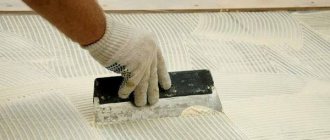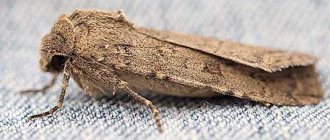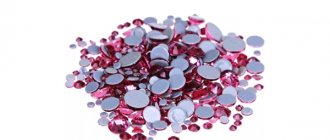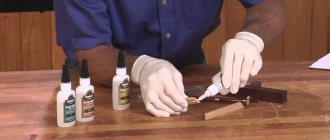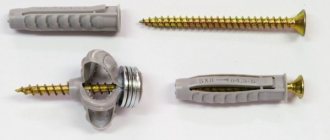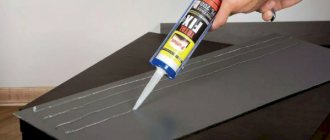The edge is used to protect the end edges of parts made of MDF, chipboard, PVC from abrasion, moisture and impact. This finish performs a decorative function, and also gives the edges and corners of furniture strength and protects people from the harmful effects of substances such as formaldehyde, which is used in the production of compressed wood boards.
If the border is damaged or peels off, urgent repairs are required. And in this case, the primary task is to select the material and glue for the edges made of PVC, melamine paper or other material.
Edge functions
When cutting parts from laminated chipboard panels, unsightly edges inevitably remain. This is due to the peculiarity of the material, its pressed structure. To disguise the cuts, a special tape is glued to the visible ribs, which
called furniture edge.
In addition to camouflage, it performs the following functions:
- protects the ends from drying out;
- prevents moisture from entering the fabric;
- blocks the penetration of dirt into pores;
- allows you to stylize and decorate an item;
- increases shock absorption during physical impact;
- corrects, hides defects and irregularities.
All of the above is especially true for cabinets, tables, and kitchen units.
In what rooms is it needed?
As was said, the edge is not only a decoration, but also protects both people and furniture, for example, from moisture. Hence it is clear that it is simply necessary for kitchen units and other furniture, since the kitchen often experiences high humidity. The same can be said about the bathroom, and just a humid climate.
In other living rooms - living room, bedroom, children's room - an edge, for example, at a window sill made of a wooden tabletop, will be protection from dangerous fumes.
Types and their features
The most striking difference between the edges is in appearance. Ribbons can be of different colors, matte and glossy, with imitation of stone, concrete, wood, leather, stucco and other textured designs.
But the main difference is the material. The final properties of the part depend on the raw materials.
Melamine
They're paper. Made from very thick paper. It is impregnated with melamine and glued to a papyrus backing and varnished, which further increases its strength.
The papyrus base can be made of one or two layers. The thickness of the tape is respectively 0.2 or 0.4 mm. The second option is more expensive, but exhibits better performance.
Melamine edges are characterized by flexibility and easy installation. Most often there is already glue on the backside, which just needs to be warmed up before applying to the end. At the same time, this is the most short-lived type. The tape quickly wears out, fades, and is fraught with excess moisture.
Suitable for back edges of shelves and table tops. Not recommended for external parts.
Polyvinyl chloride
In other words, PVC. A mass of raw materials is formed into a tape, textures are applied and painted in different shades. The imitation of wood fibers is especially successful. The low price does not in any way affect the quality during use. One of the easiest options for self-gluing.
PVC edges withstand contact with objects, household chemicals, ultraviolet radiation, and water. They fit large curves and curves without any problems. Available with or without an adhesive layer.
Thickness varies from 0.4 to 4 mm. The width can be any in the range from 19 to 54 mm. As a rule, the size is chosen slightly with a margin from the end.
Expert opinion
Korzhavin Daniil Dmitrievich
Designer of stylish home furniture
The main disadvantage of PVC tapes is their poor tolerance to sudden temperature changes. Heating during installation must be done extremely carefully; furniture should not be left in the cold or in extreme heat for a long time.
ABS plastic
Edges made of ABS polymer material. They are good because they do not contain heavy metals, which makes them as safe as possible from an environmental point of view. They are also distinguished by excellent strength and long service life, despite active physical impacts.
They tolerate temperature changes well. They successfully imitate natural materials with their texture, including different types of wood. Available in glossy, semi-gloss, matte versions.
Despite the ease of gluing with any heat-resistant composition, they have some nuances in operation. When choosing ABS plastic, it is worth remembering that it shrinks when heated. The size of the tape should be approximately 0.3-0.5 mm wider and longer than the end itself.
The main disadvantage is the high price.
Veneer
Veneer is not the most sought-after material in the edging world, but it has its place. Such edges resemble thin plates rather than ribbons. They are made by thinly cutting wood, followed by pressing and painting.
Most often, veneer edges are used when processing problematic veneered products. They are expensive and require professional skills to operate. Rarely used independently.
Acrylic 3D
Edges made of transparent hardened acrylic. They resemble an aquarium or a piece of glass - there is a drawing on the back side. The structure makes the tape voluminous and creates beautiful highlights. The ability to make any ornament opens up scope for design activity.
It is actively used for decorating cabinets, chests of drawers, tables, and doors. Requires care in cutting, cutting and gluing, as seams can be noticeable.
Expert opinion
Korzhavin Daniil Dmitrievich
Designer of stylish home furniture
The cost remains high. Many companies allow manufacturing according to an individual project.
How to glue an edge (tape) to a tabletop with your own hands: step-by-step instructions
For the work to be successful, you must adhere to the following instructions:
- The table top is installed with the end facing up, making it more convenient to work.
The cut of the tabletop should be smooth, not sprinkled. The edge strip will not hide unevenness; it adheres well only to an even cut.
- The end is cleaned of dirt and dust deposits.
- The edge is applied for measurement, and the required part is cut to size.
- A strip is installed on the end part of the tabletop with the adhesive layer down.
- The iron warms up on the program for ironing synthetic materials.
- The paper is placed on the tape, ironed for three minutes, while the adhesive layer warms up under temperature, melts and sticks the strip.
- The edge is adjusted to size and trimmed.
If an ABS strip is used, it is difficult to cut and burrs may remain on the edges. They are carefully removed with fine-grained sandpaper.
If a hairdryer is used for heating, then for strong adhesion the strip must be ironed with a roller.
We recommend videos on the topic:
Difference from profiles
Finishing profile
Very often there is confusion with the concept of edge and finishing profile. You can disguise the end of the furniture with both, but the products are strikingly different from each other.
Profiles are made of PVC, wood, aluminum of different hardness. They are sold with a section in the letters T and C (aka P), and are slightly moldable. The edges are produced smooth, straight, and much more flexible.
The most important difference is the installation method. The edges are always glued with glue. Profiles are inserted into a milling groove (T form) or put on with a hook at the bottom and top of the end (C form). To shrink the profiles, they are “nailed” on top with a rubber mallet. Sometimes they are additionally glued or fixed with finishing nails.
The end for the profiles must be processed as carefully as possible - the edges are trimmed, the surface is sanded. Otherwise it will not sit correctly. There is no such problem with edges.
Why do you need to process the ends?
We list the main reasons to process the ends:
- Aesthetics. Leaving your countertops untreated is like brushing only your upper teeth and not your lower teeth. A lot of time is spent in the kitchen, and it is important that the furniture and surroundings bring only positive emotions.
- Extending service life. Here we are talking not only about mechanical damage, but also about splashes of water, clouds of steam and simply temperature changes. The edge seals the end and protects it from all negative influences, extending its service life.
- Health protection. The fact is that formaldehyde resins, harmful to human health, can evaporate through the open edge of a cheap chipboard tabletop, so finishing the ends is simply necessary.
- Masking of defects. If the edge of the tabletop was damaged during transportation (which happens very often), then a correctly selected edge will hide everything.
Installation technology
Before starting work, you will need to prepare the surface and collect the necessary accessories.
Toolkit includes:
Glue Moment, Liquid Nails or construction PVA (if not a self-adhesive type of edge).
The edge itself (calculate the quantity in advance around the perimeter with a margin of at least 20 cm).
Sanding block or fine sandpaper.
Painting knife, scissors (depending on the softness of the edge).
Pressure rubber roller.
Thick rags.
Hair dryer or iron.
A file and wood putty may be needed if the end has large defects.
The main task of preparing an object is to remove all burrs, seal large holes, and level the surface as much as possible. When using sandpaper, the surface must be completely dry. If putty is used, it must be given time to completely cure. Then start gluing the tape.
How to glue
The algorithm for using tape without an adhesive layer and with it is slightly different.
Self-adhesive
- Measure and cut a piece of tape 2-3 cm larger than the end.
- Apply an area of about 20 cm, level it and heat it with a heated iron or hairdryer for several seconds.
- Roll the heated area with a roller.
- Proceed to the next segment. Continue this way the entire length.
- Trim off excess tape with a paint knife. Glue the edge.
Without adhesive layer
- Measure and cut off the tape to spare.
- Apply glue to the end and level the layer.
- Wait for the initial drying time (indicated on the packaging for each type of glue).
- Apply the tape in small sections, rolling it with a pressure roller.
- Wait until the adhesive has completely cured. Cut off excess.
When working with a self-adhesive edge, it is possible to level the entire length to the end, secure it with masking tape in several places, then warm it up. Before treating the area with tape, it must be removed before heating.
Expert opinion
Korzhavin Daniil Dmitrievich
Designer of stylish home furniture
Adhesive may come out during the process. It is collected with rags immediately, without waiting for it to dry.
PVC strip
A more progressive and aesthetically pleasing way. True, its implementation requires some skill, but after practicing on scraps, you can master this method.
The edge, resistant to abrasion and moisture, will ensure long-term use of the tabletop in any interior.
When gluing the PVC edge, follow the following sequence.
- Cut a strip of finishing material 2 cm longer than the edge to be processed.
- Heat the edge with a hair dryer on the glue side or with an iron on the front side.
To glue the edges, use an industrial hair dryer with a heating temperature of 250 degrees.
If you are using a material without an adhesive base, use “88-Lux” glue or something similar.
Apply to the cut strip and wait for the time specified according to the instructions. In 2-3 minutes. Before the end of the period, cover the end of the tabletop with a thin layer of glue.
The blade of the knife should go along the plane of the part, thus evenly cutting off the protruding part of the edge.
The edge treated with fine-grit sandpaper will be even and smooth.
A properly selected and glued edge will give the tabletop an attractive appearance, and it will serve you for many years.
You can also get such a smooth and neat edge yourself.
Lifehacks
Professionals advise paying attention to the following tricks:
- Ends hidden from view are often not processed. This is acceptable according to GOST, but in practice it is not very reasonable. It is optimal to go through parts that are invisible during operation with at least the thinnest melamine edge. This will reduce the absorption of vapors and moisture, and extend the life of the furniture. Relevant for shelves, drawer bodies, countertops.
- When working with an iron, it is highly advisable to wear a fluoroplastic attachment or add thick cotton. This reduces the risk of overheating the glue and melting the tape itself.
- The edges are selected either tone-on-tone or in strong contrast. A difference of 1-2 tones will make the furniture visually uneven.
How would you disguise the end of the furniture?
EdgeProfile
- To improve the fit, the ends must first be vacuumed and wiped with alcohol to degrease.
- The optimal heating for an iron and hair dryer is medium mode (usually 2).
- For facades and external ends it is better to use PVC edges 2 mm thick. There the friction is highest.
If it is necessary to replace the old tape, it is removed in the same way, but in reverse order. Heat the surface, use a knife or spatula to separate a piece from the end. Clean the surface, then begin installing fresh material.
Tools
If you decide to glue the edge yourself, check that you have the tools. Prepare before starting work:
- Iron, which is necessary for gluing with melamine edge;
Furniture edges can be glued at home using a regular iron.
A hair dryer is the most convenient method of heating the edge.
It will become a convenient device for pressing the edge tightly.
The processed ends are smoothed with it.
You will need scissors to cut the desired length of the edge.
It cuts off the excess edge hanging from the edges of the part.
Use glue if your material does not have an adhesive base.
With a solvent you can easily remove traces of glue.
It is convenient to remove excess glue with a rag soaked in solvent.
To fix the PVC edge, you can use a clamp and a wooden block. If possible, use a hand router to finish the edging.
The router is expensive and it is not profitable to buy it for one-time pasting.
Prepare your workspace, taking into account the space for turning the tabletop. And, most importantly, buy the appropriate melamine tape or PVC edge.
Choose a ribbon that matches the color of the countertop.
FAQ
Can there be a cheap edge on expensive factory furniture?
Hardly. Manufacturers do not skimp on such details, realizing that the durability of the product depends on this. If the edge is cheap, the price is likely unreasonably high.
How to properly make joints on furniture edges?
It is advisable not to do them at all. The following approach will allow you to avoid joints: round the corners with a file, measure the entire perimeter of the tape, start gluing from the center of the front end, first going around the left side, then along the right. You need to connect the ends in the center of the rear end, in a place that is most invisible to the eye.
If this option is unacceptable or the edge is hard, you can leave sections at the corners and cover the seams with decorative overlays.
On veneer, the joints are sealed with putty, sanded and the entire perimeter is coated with varnish, wax or paint.
The edge breaks when cutting off excess. What to do?
The problem may be a dull blade or the direction of movement of the knife. The cutting is carried out inside the part, from top to bottom. To be on the safe side, you can use a metal spatula.
The hard edge does not adhere well.
For complete pressing, you can use a wooden beam the length of the entire end. After rolling with a roller, you need to press the block on top, secure it with tape or clamps and leave it until the glue dries completely.
Common Mistakes
The most common mistakes made by inexperienced craftsmen include:
- Bubble formation. Occurs due to weak heating of the adhesive base or poor pressing of the edge to the part. You will have to reheat it with the iron and press it more carefully.
- Edge offset. It is important to eliminate this defect quickly by returning the part to its place. Otherwise, you will have to tear off and glue a new piece.
- There were pieces of dried glue left on the furniture. The adhesive must be removed while it is hot, before it dries and hardens. This is done with gloves to avoid damaging your hands.
Hardened glue is removed with sandpaper or solvent. It is important to choose the appropriate remedy.
Tip: edging is necessary even for invisible areas of furniture - it will protect the chipboard from absorbing moisture and deforming the material.
